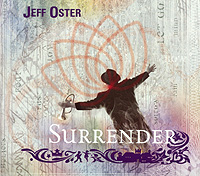 There’s
something so elegant, so funereal, so stately about the sound of the
trumpet and its sister, the flugelhorn. Certain progressive rock groups
including Mark Isham’s band Group 87 and the late, great Finnish
master composer Pekka Pohjola each used the trumpet to great effect
and then don’t forget Jon Hassell and his otherworldly trumpet
work with Brian Eno. So now in 2011 along comes master trumpeter Jeff
Oster and his amazing album entitled Surrender.
Released on Oster’s own Retso Records label, the CD is not
only superbly recorded and performed but the packaging is really amazing
with phenomenal design and insert. Backing up Oster’s trumpet,
flugelhorn, synths, loops and occasional vocals is the like minded
Bryan Carrigan, who is credited here with sound design, synths,
and drum programming and the occasional wordless, yet highly effective
backing vocals of Diane Arkenstone. Whereas a master trumpeter
such as Chris Botti is content to go commercial, credit his producer
mastermind Bobby Colomby, Oster is very experimental in his approach—here
reminiscent of Miles Davis produced by Eno. The majority of music
here is completely instrumental, making Surrender the perfect
choice for trumpet fans, New Age classical fans and ambient / electronic
listeners who are looking for some fantastic sonic thrill. New Age
and neoclassic art-rock fans, miss this at your own risk. www.JeffOster.com
/ www.BryanCarrigan.com
/ www.DianeArkenstone.com
There’s
something so elegant, so funereal, so stately about the sound of the
trumpet and its sister, the flugelhorn. Certain progressive rock groups
including Mark Isham’s band Group 87 and the late, great Finnish
master composer Pekka Pohjola each used the trumpet to great effect
and then don’t forget Jon Hassell and his otherworldly trumpet
work with Brian Eno. So now in 2011 along comes master trumpeter Jeff
Oster and his amazing album entitled Surrender.
Released on Oster’s own Retso Records label, the CD is not
only superbly recorded and performed but the packaging is really amazing
with phenomenal design and insert. Backing up Oster’s trumpet,
flugelhorn, synths, loops and occasional vocals is the like minded
Bryan Carrigan, who is credited here with sound design, synths,
and drum programming and the occasional wordless, yet highly effective
backing vocals of Diane Arkenstone. Whereas a master trumpeter
such as Chris Botti is content to go commercial, credit his producer
mastermind Bobby Colomby, Oster is very experimental in his approach—here
reminiscent of Miles Davis produced by Eno. The majority of music
here is completely instrumental, making Surrender the perfect
choice for trumpet fans, New Age classical fans and ambient / electronic
listeners who are looking for some fantastic sonic thrill. New Age
and neoclassic art-rock fans, miss this at your own risk. www.JeffOster.com
/ www.BryanCarrigan.com
/ www.DianeArkenstone.com
mwe3.com
presents an interview with
JEFF OSTER
mwe3: Your new CD Surrender is a masterpiece of evocative instrumental
music. What did you set out to accomplish musically with the Surrender
album and how would you describe the sound? I know some music fans
are saying it sounds like Miles Davis meets Enya!
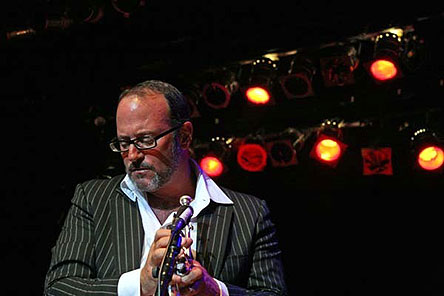 JEFF
OSTER: Thank you, Robert! My goal with Surrender was to create
the soundtrack for a chilled, downtempo walk through the streets of
Soho in downtown Manhattan at 2 am after a light rain. You know, a
little mist hanging in the air…the light reflecting off of the
wet cobblestones. I’ve always wanted to capture that feeling
in music, one of mystery and of sensuality with a little bit of dancing
thrown in for good measure.
JEFF
OSTER: Thank you, Robert! My goal with Surrender was to create
the soundtrack for a chilled, downtempo walk through the streets of
Soho in downtown Manhattan at 2 am after a light rain. You know, a
little mist hanging in the air…the light reflecting off of the
wet cobblestones. I’ve always wanted to capture that feeling
in music, one of mystery and of sensuality with a little bit of dancing
thrown in for good measure.
mwe3: What was it like working with your co-writer Bryan Carrigan
on the Surrender album? How do you work on the compositions
with Bryan and what did he bring to the album sound and vision? Also
how about the vocal by Diane Arkenstone on the “Surrender”
title cut? How did you meet both Bryan and Diane and can you say something
about them and are you planning further work with them in the future?
JO: I met Bryan back in 2005 when he was the recording and mixing
engineer on my album Released. We met at Will Ackerman’s
Imaginary Road Studios in Vermont, where I recorded Released.
Will produced my first two records, Released and True,
and at that time Bryan was living in Boston. When I was ready to mix
Released, Bryan had moved to Los Angeles to work with several
film composers, continuing his work as a producer, engineer, synth
programmer, sound designer, remixer and composer of electronic music.
We worked together to mix Released, and then True in
2007, and we developed a really nice way of working together.
He and I have a lot of common sensibilities—we both love electronic
music, cool beats, and Bryan is also a trumpet player. We talked quite
a bit about creating a new album together incorporating some of these
elements during those mixing sessions, and he was the only one I thought
of when the time came to begin work on SURRENDER.
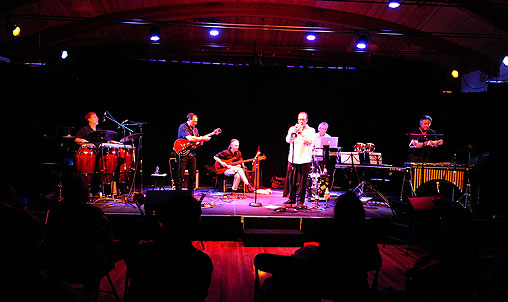 Bryan
is an amazing sound designer—you can hear it all over Surrender.
All of the drum programming and synth sounds, really almost all of
the tracks you hear except for my horn and Diane Arkenstone’s
vocals were created by Bryan. He is amazing.
Bryan
is an amazing sound designer—you can hear it all over Surrender.
All of the drum programming and synth sounds, really almost all of
the tracks you hear except for my horn and Diane Arkenstone’s
vocals were created by Bryan. He is amazing.
When the time came to begin recording, Bryan and I would work to capture
a certain vibe at the beginning of the day—a bass line, a synth
pad, the sound of a bell—that’s all we’d begin with,
and build up a track from there. By the afternoon, I’d go in
and record a trumpet or flugelhorn part, then add harmonies to that,
and by the end of the day we’d have the makings of a song.
One of my goals for this album was to try to capture some free blowing
horn parts. My previous releases were a bit more orchestrated and
arranged. I wanted this one to have more of a “live” feel...as
if you were at a club listening, or hearing it as you walked past
the bar late at night. I think we did that.
Diane and I had known each other for a while before I began recording
Surrender. She is an amazing talent, incredibly prolific and
possesses one of the sweetest voices on the planet. She is the only
other acoustic presence on Surrender, other than my horn. We
were lucky enough to have her come into the studio for a day, and
what you hear is the result of that session. She nailed it, don’t
you think?
I would love to work with both Bryan and Diane again. They are awesome
talents, and wonderful human beings. Both Bryan and Diane have new
albums coming out, and I encourage all of you to check them out.
mwe3: What is your background in the music world? When did you start
studying music and how did you gravitate towards the trumpet and flugelhorn
and how does that contrast with and enhance your keyboard style and
overall sound on the Surrender album?
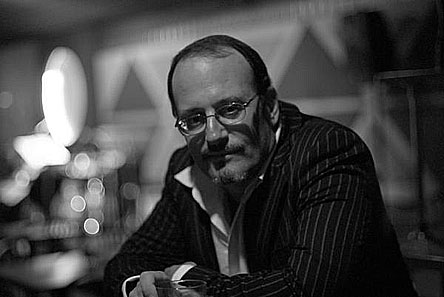 JO:
I started playing the trumpet when I was 8 years old. I told my parents
that I wanted to “play the melody”, and so I chose the trumpet.
My first paying gig was playing “Taps” at a funeral when
I was a junior in high school. I stood behind a tree, and was paid
ten dollars.
JO:
I started playing the trumpet when I was 8 years old. I told my parents
that I wanted to “play the melody”, and so I chose the trumpet.
My first paying gig was playing “Taps” at a funeral when
I was a junior in high school. I stood behind a tree, and was paid
ten dollars.
I continued with lessons all through school, and joined my first band
in 1975 while I was living in Miami. It was a 3 piece power rock trio
playing Pink Floyd, Neil Diamond and some originals. As you might
imagine, not every song needed a trumpet, so I learned how to play
percussion and eventually keyboards.
I added the flugelhorn in 1977, after being inspired by Chuck Mangione.
I still play the same Yamaha flugelhorn I bought sight unseen through
the mail back then, and it’s my favorite instrument to play.
I love the warm sweet tone I get from the flugel. I’ve never
been a high note lead trumpet player, or a hard bop jazz player. I
just want to make the horn sound as sweet as I can.
mwe3: Can you say something about what trumpets and flugelhorns you
play and who were some of your favorite trumpet / flugelhorn players
when you started and now too? Plus, based upon your background, how
would you say or explain how adapt both jazz and classical music into
your recording / live sound and style?
JO: I play a Bach Stradivarius trumpet, and Yamaha flugelhorn. I also
have a Jupiter pocket trumpet and a Yamaha cornet, but I don’t
record with those. I’m thinking of checking out a Martin trumpet,
the kind Miles and Chris Botti have played, but so far I’m comfortable
with what I’ve been playing for decades now.
As I was growing up, I loved Herb Alpert. I spent hours with his Whipped
Cream album...Oh yeah, listening to the music too! (lol) and as
I grew a bit older, got into Miles and Louis Armstrong, Bill Chase
and some Mark Isham and Chet Baker as well. I really love Chris Botti’s
work today as well, along with a few others such as Kiku Collins and
Gabe Hasselbach.
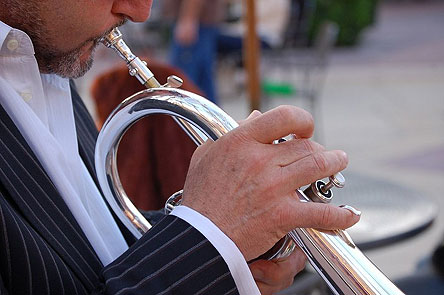 Unlike
many horn players I have not studied all of the major trumpet players
extensively. I think in some kind of weird way this has allowed me
to create my own original music that is a bit unique. As I grew up,
I loved to listen to Steely Dan, Yes, Pink Floyd, The Orb, Frankie
Goes to Hollywood, as well as Alice Cooper, Steve Miller, and Crosby
Stills and Nash.
Unlike
many horn players I have not studied all of the major trumpet players
extensively. I think in some kind of weird way this has allowed me
to create my own original music that is a bit unique. As I grew up,
I loved to listen to Steely Dan, Yes, Pink Floyd, The Orb, Frankie
Goes to Hollywood, as well as Alice Cooper, Steve Miller, and Crosby
Stills and Nash.
My live shows especially are very electronic and processed much like
you hear with Jon Hassell, Nils Petter Molvaer and a few other ECM
artists. I work quite a bit with bassist Michael Manring, and guitarist
Carl Weingarten—both known for their unique approaches to traditional
instruments. Our live “songs” last for an hour or more without
stopping sometimes, live loop based excursions into the sort of space
that jam bands like Phish or The Grateful Dead might explore—only
with trumpet/flugelhorn, fretless bass and slide guitar.
mwe3: How do you combine keyboards, synths, samplers and looping effects?
Also what keyboards do you use, play and recommend and what effects
do you use in the studio and live to achieve that amazing ethereal
effect live and on the Surrender album?
JO: Most of what you hear on Surrender was created “in
the box” by Bryan Carrigan. He is a master of designing and tweaking
synth sounds, drum beats, and processing my horn sound to get that
“special sauce” you hear all over Surrender.
For my live work, I use a combination of effects—a TC Helicon
Voicetone Create effects foot pedal, usually used for vocalists, a
Line Six M-9 Stompbox modeler, designed for guitarists, and a Boss
RC-20XL Loop Station to build up some looping on a real time basis.
All of this results in some pretty trippy sounding live horn sound.
I’ve also recently began to incorporate an iPod Touch into the
mix—programs like Brian Eno’s Bloom and Trope, as well as
tracks created with NanoStudio software for iPod add some pretty cool
flavors into my live experience.
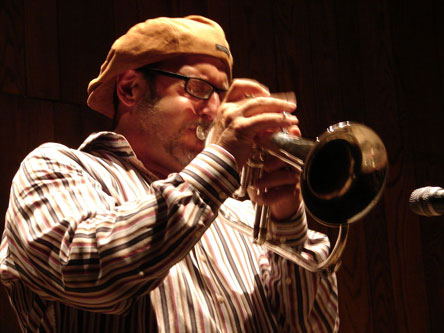 mwe3:
A while back you worked with New Age pioneer Will Ackerman of Windham
Hill Records. What was that experience like, how did you guys meet
up and can you say something about the two albums you recorded with
Will—Released and True and who played with you
on those albums, where and when were they recorded and are the CDs
still available?
mwe3:
A while back you worked with New Age pioneer Will Ackerman of Windham
Hill Records. What was that experience like, how did you guys meet
up and can you say something about the two albums you recorded with
Will—Released and True and who played with you
on those albums, where and when were they recorded and are the CDs
still available?
JO: Working with Will Ackerman is the highlight of my musical career.
I first heard his music back in 1977 when I lived in Eugene, Orgeon,
and for years I spent hours at home playing my horn along with his
records. I told myself early on that if I ever had the chance to be
involved with Will, and Windham Hill, that I would jump at the opportunity.
It took me until 2003 to make that a reality. By that time, Windham
Hill was for the most part gone, but Will was and is active as a producer.
I began to create loops at home, then adding horn parts and uploading
the demos to mp3.com. After I began to top the ambient charts there,
I reached out via e-mail to Will. By this time, he was living in Vermont,
working out his studio there called Imaginary Road. He e-mailed me
back, I met him at his studio in Vermont, and we agreed to work together.
We created an EP called At Last in 2004, then recorded Released
in 2005, and True in 2007. Both Released and True
were voted Album of the Year by broadcasters at New Age Reporter (now
ZoneMusicReporter.com), and songs from each won “Best New Age
Song” at the Independent Music Awards.
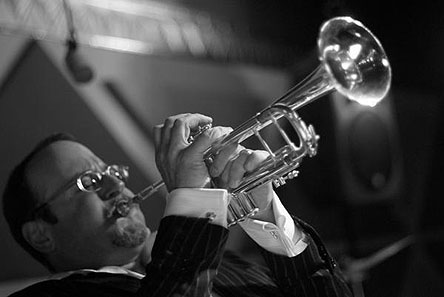 I
was able to work with some amazing artists on the albums produced
by Will Ackerman—Keith Carlock on drums (Steely Dan’s drummer),
Eugene Friesen (Grammy winning cellist), Philip Aaberg (Grammy winning
pianist), Happy Rhodes, the incredible singer songwriter, the late
great T. Bone Wolk (bassist and producer for Hall and Oates, a.o.),
and many more fine artists. We were able to work with Bruce Swedien,
the engineer on Michael Jackson’s Thriller and many other
legends.
I
was able to work with some amazing artists on the albums produced
by Will Ackerman—Keith Carlock on drums (Steely Dan’s drummer),
Eugene Friesen (Grammy winning cellist), Philip Aaberg (Grammy winning
pianist), Happy Rhodes, the incredible singer songwriter, the late
great T. Bone Wolk (bassist and producer for Hall and Oates, a.o.),
and many more fine artists. We were able to work with Bruce Swedien,
the engineer on Michael Jackson’s Thriller and many other
legends.
In addition to all of the above, I was able to co write and record
several songs with Will—as you might imagine, going from a die
hard fan to performing with someone like him remains one of the high
points of my life. On top of all of it, he has become one of my closest
friends as well. Never in a million years would I have imagined that
not only would I record with Will, but we’d become lifelong brothers
as well. Dreams do come true.
Both Released and True are available at http://music.jeffoster.com,
as well as on iTunes, Amazon, CD Baby and all of the other places
fine music is sold.
mwe3: What musicians do you play with live and in the studio these
days such as Carl Weingarten and Michael Manring Where do you live
these days and what do you like best about where you live and work?
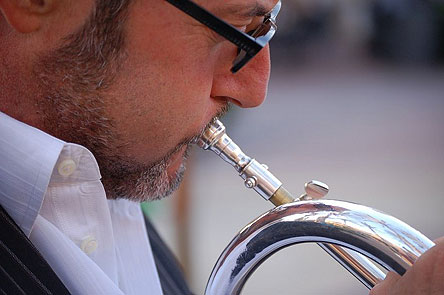 JO:
As I mentioned earlier, I have been playing quite a bit with Carl
and Michael. We usually add percussionist Dave Dilullo here in the
Bay Area, as well as pianists Kelly Park and Troy Arnett. Carl is
finishing up a new album, and we work from time to time here in the
San Francisco Bay area where we all live, as well as a few gigs on
the road when I can make those happen.
JO:
As I mentioned earlier, I have been playing quite a bit with Carl
and Michael. We usually add percussionist Dave Dilullo here in the
Bay Area, as well as pianists Kelly Park and Troy Arnett. Carl is
finishing up a new album, and we work from time to time here in the
San Francisco Bay area where we all live, as well as a few gigs on
the road when I can make those happen.
I also have been working with a world flute artist named Ann Licater,
as well as sitting in with guitarists Todd Boston and Shambhu. I also
work locally here with a 12 piece Motown band. 5 horns, 3 vocalists,
a rhythm section—it’s a blast!
As you might imagine, living and working in the San Francisco Bay
Area is a delight. There are some great musicians here, it is a beautiful
environment, and the whole West Coast experience is second to none.
mwe3: What are your future plans moving forward on the Surrender
album and future plans live, studio and otherwise? Thank you Jeff...
 JO:
Robert, thanks to you and others, Surrender is making its way
into the world. It is on the ballot for this year’s Grammy Awards
for Best New Age Album, and the music is being played and well received
throughout the world.
JO:
Robert, thanks to you and others, Surrender is making its way
into the world. It is on the ballot for this year’s Grammy Awards
for Best New Age Album, and the music is being played and well received
throughout the world.
For the month of September 2011, Surrender is number one on
NPR’s Echoes Radio show, as well as number one on the ZoneMusicReporter.com
charts for worldwide radio airplay. I’m always open to new live
show opportunities  anywhere
in the world, and look forward to beginning work on my next album.
anywhere
in the world, and look forward to beginning work on my next album.
Until then, if you’d like to experience my live show online,
my YouTube channel is http://www.youtube.com/ffejretso.
I can be reached for bookings as well at management@retsorecords.com
It’s been great chatting with you! Thank you for the great
work you do at mwe3.com!
Thanks to Jeff Oster @ www.RetsoRecords.com



